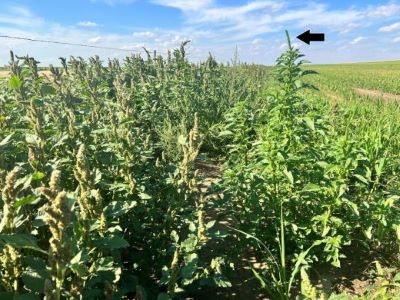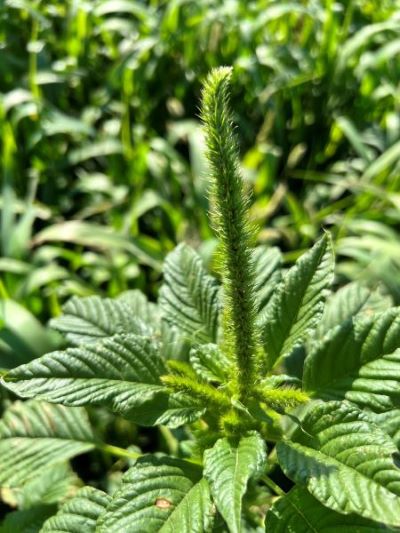Update on Palmer amaranth and waterhemp in Montana
By Noelle Orloff, Associate Extension Specialist and Schutter Lab Diagnostician
Introduction

Photo; Inga Hawbacker, MSU Extension
Palmer amaranth (Amaranthus palmeri) and waterhemp (A. tuberculatus) are annual species that have limited known distribution in Montana. If they become established, they will have a large economic impact on Montana agriculture. These plants have biological characteristics that allow them to readily develop herbicide resistance, and both species have biotypes in the United States known to be resistant to multiple herbicide modes of action. Both are also very competitive with crops in the right situation. Palmer amaranth is a restricted seed species in Montana, meaning seed known to be contaminated cannot be sold in the state.
Identification

Photo; Inga Hawbacker, MSU Extension
Palmer amaranth and waterhemp have many close relatives in Montana, making identification challenging. Watch for pigweeds (Amaranthus species) that look different than common species such as redroot pigweed (A. retroflexus). Palmer amaranth and waterhemp are usually taller than common pigweeds, and have longer, skinnier inflorescences (photo, top right). Visual identification also involves determining whether flowers on a plant are all male or all female (dioecious – likely Palmer amaranth or waterhemp), or if there is a mix of both on the same plant (monoecious – likely a common pigweed). When Palmer amaranth or waterhemp is identified visually by the Schutter Lab, we confirm its identity via PCR testing services. For more information about identifying these species, see the factsheets at the links below.
Situation in Montana
There are two known records of Palmer amaranth occurring in Montana.In September 2023 several flowering Palmer amaranth plants were found growing in a field in Daniels County, and they were removed from the field prior to seed production. Earlier in 2023, one male plant was found in Toole County growing under a bird feeder: likely a contaminant in bird seed. Two waterhemp populations have also been detected in recent years. One population was found in an irrigated durum field in Roosevelt County in 2020, and a few plants were spotted and removed from a sugarbeet field in Prairie County in 2021. The Montana Department of Agriculture and MSU Extension are working together to raise awareness of these plants, advise affected growers on management, and to limit further spread and establishment.
What to do if you suspect Palmer amaranth or waterhemp
Contact your local Extension office or agronomist if you suspect you have found either of these species or if you have questions about their identification. You can also visit the Palmer amaranth task force webpage for more information and to report suspected populations.
Additional resources
Visit the MSU Extension store online for factsheets summarizing information about both Palmer amaranth and waterhemp. Also at the Extension store, see the Pigweed Prevention flyer.
Further Information
For more information about this month's weed post, contact Associate Extension Specialist Noelle Orloff. Past posts are available in the Monthly Weed Post Directory.
This weed post is also available as a printable PDF (222 KB).
